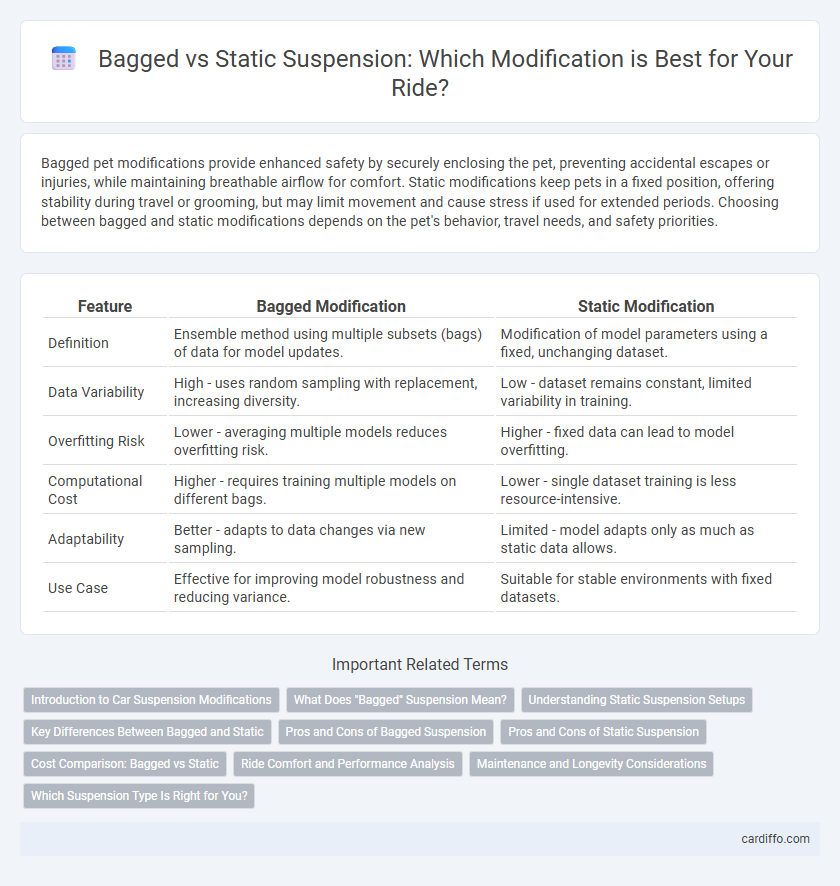Bagged pet modifications provide enhanced safety by securely enclosing the pet, preventing accidental escapes or injuries, while maintaining breathable airflow for comfort. Static modifications keep pets in a fixed position, offering stability during travel or grooming, but may limit movement and cause stress if used for extended periods. Choosing between bagged and static modifications depends on the pet's behavior, travel needs, and safety priorities.
Table of Comparison
| Feature | Bagged Modification | Static Modification |
|---|---|---|
| Definition | Ensemble method using multiple subsets (bags) of data for model updates. | Modification of model parameters using a fixed, unchanging dataset. |
| Data Variability | High - uses random sampling with replacement, increasing diversity. | Low - dataset remains constant, limited variability in training. |
| Overfitting Risk | Lower - averaging multiple models reduces overfitting risk. | Higher - fixed data can lead to model overfitting. |
| Computational Cost | Higher - requires training multiple models on different bags. | Lower - single dataset training is less resource-intensive. |
| Adaptability | Better - adapts to data changes via new sampling. | Limited - model adapts only as much as static data allows. |
| Use Case | Effective for improving model robustness and reducing variance. | Suitable for stable environments with fixed datasets. |
Introduction to Car Suspension Modifications
Car suspension modifications can be divided into two primary categories: bagged and static setups. Bagged suspensions use air springs to provide adjustable ride height and improved comfort, while static setups rely on coilovers or lowering springs for a fixed, performance-oriented stance. Understanding the differences in ride quality, handling, and customization options is essential for selecting the best suspension modification for a vehicle.
What Does "Bagged" Suspension Mean?
Bagged" suspension refers to a vehicle suspension system that uses air springs or airbags instead of traditional steel springs, allowing for adjustable ride height and improved ride comfort. This setup enables drivers to modify the vehicle's stance and handling characteristics by inflating or deflating the airbags, typically controlled via an onboard compressor system. Bagged suspensions offer enhanced flexibility compared to static suspension setups, which use fixed components and cannot be easily adjusted after installation.
Understanding Static Suspension Setups
Static suspension setups feature non-adjustable components designed to maintain consistent ride height and stiffness, improving predictability in vehicle handling. Unlike bagged systems that use air pressure for customizable ride height, static suspensions rely on fixed springs and dampers optimized for specific performance needs. Understanding static suspension setups involves recognizing their role in providing stable, repeatable chassis dynamics ideal for track or performance driving.
Key Differences Between Bagged and Static
Key differences between bagged and static modification methods lie primarily in their approach and flexibility; bagged modification involves combining multiple models or data instances to improve accuracy and robustness, while static modification applies a fixed alteration to a single model or dataset. Bagged methods reduce variance and enhance generalization by aggregating diverse predictions, whereas static modifications may introduce bias by relying on a singular transformation. Understanding these distinctions is crucial for selecting the appropriate strategy based on the desired balance between model complexity and performance stability.
Pros and Cons of Bagged Suspension
Bagged suspension offers superior ride comfort and adjustable ride height, enhancing vehicle versatility for various driving conditions. However, it tends to be more expensive to install and maintain compared to static suspension, with potential issues such as air leaks and compressor failure. While bagged systems provide smoother handling and load-leveling benefits, they often sacrifice some reliability and require more frequent servicing.
Pros and Cons of Static Suspension
Static suspension systems offer superior ride comfort and stability by maintaining a constant ride height regardless of load, making them ideal for heavy-duty vehicles and off-road conditions. However, they lack the adaptability of bagged suspension systems, resulting in less flexibility for adjusting ride height and stiffness, which can impact performance on varying terrains. Maintenance requirements tend to be lower in static suspension due to fewer components susceptible to wear compared to air-sprung bagged systems.
Cost Comparison: Bagged vs Static
Bagged air filters generally incur higher replacement costs due to their more complex design and frequent maintenance requirements compared to static filters, which typically have lower upfront and operational expenses. Static filters benefit from longer service lives and reduced labor costs, making them more cost-effective for large-scale or continuous applications. When evaluating total cost of ownership, static filters often deliver superior value, especially in environments with moderate dust loads and less stringent air quality demands.
Ride Comfort and Performance Analysis
Static suspension systems offer consistent handling but often compromise ride comfort due to limited adaptability to road variations. Bagged suspension enhances ride comfort by adjusting air pressure, allowing for smoother absorption of bumps and improved shock distribution. Performance analysis shows bagged setups provide superior adaptability and cushioning, resulting in better ride quality during diverse driving conditions compared to static suspensions.
Maintenance and Longevity Considerations
Bagged equipment requires regular replacement of collection bags to maintain optimal performance and prevent clogs, impacting ongoing maintenance costs and labor. Static systems use fixed filters that demand periodic cleaning or replacement based on usage, influencing overall durability and lifespan. Selecting between bagged and static modifications depends on the balance between maintenance frequency, filter longevity, and operational efficiency.
Which Suspension Type Is Right for You?
Choosing between bagged and static suspension depends on your driving needs and comfort preferences. Bagged suspension offers adjustable ride height and improved comfort, ideal for varying terrains and load conditions. Static suspension provides a fixed setup, favored for simplicity, stability, and consistent performance on smooth roads.
bagged vs static Infographic

 cardiffo.com
cardiffo.com